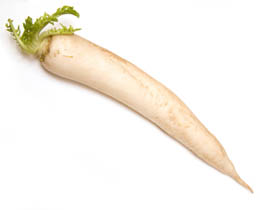A White Radish with Spirit
- By FruitGuys Staff
- Reading Time: 2 mins.
 Author Michael Pollan says, “Eat food. Mostly plants. Not too much.” It sounds like a Zen koan, doesn’t it? By “food,” Mr. Pollan means eating non-processed, natural fare. He says, “If your grandmother wouldn’t recognize it, don’t eat it.” That rules out the center aisles of the supermarkets where the snacks are usually found. Instead of chips, he encourages us to eat locally and seasonally—and cook at home instead of going out for big carbon-footprint meals.
Author Michael Pollan says, “Eat food. Mostly plants. Not too much.” It sounds like a Zen koan, doesn’t it? By “food,” Mr. Pollan means eating non-processed, natural fare. He says, “If your grandmother wouldn’t recognize it, don’t eat it.” That rules out the center aisles of the supermarkets where the snacks are usually found. Instead of chips, he encourages us to eat locally and seasonally—and cook at home instead of going out for big carbon-footprint meals.
Daikon radish may be new to some, but it’s possible you’ve had it and not known it. It’s the tiny white vegetable in Japanese miso soup. In Punjabi cuisine, it’s called mooli. And in Eastern European dishes it is “white radish,” often served with sour cream dressings. It’s an extremely versatile vegetable and takes well to being cooked, pickled, or eaten raw. Because of the daikon radish’s cool, sweet, and pungent characteristics, it’s used in Chinese medicine for detoxification and healing certain lung conditions. Daikon contains the active enzyme myrosin, a defense-related enzyme. That makes this vegetable helpful in digestion, particularly of starchy foods.
White and diaphanous, the daikon can be sliced or cut into shapes to add to the aesthetics of any plate. The long white form (also called icicle radish) can have a ghostly appearance. On occasion, a daikon will emerge from the soil in a forked shape (looking like legs), which is known as futamata daikon in Japan. These aberrant veggies are left as offerings at roadside shrines.
Preparation: Peel and slice or dice. A Japanese secret to cooking daikon so it stays white is to boil it in the water used to wash rice.
Storage: Keep in a plastic bag in the fridge. This root veggie is still good even if it gets a little limp. Lasts for two weeks.


